2021 HYUNDAI ELANTRA HYBRID climate control
[x] Cancel search: climate controlPage 291 of 555
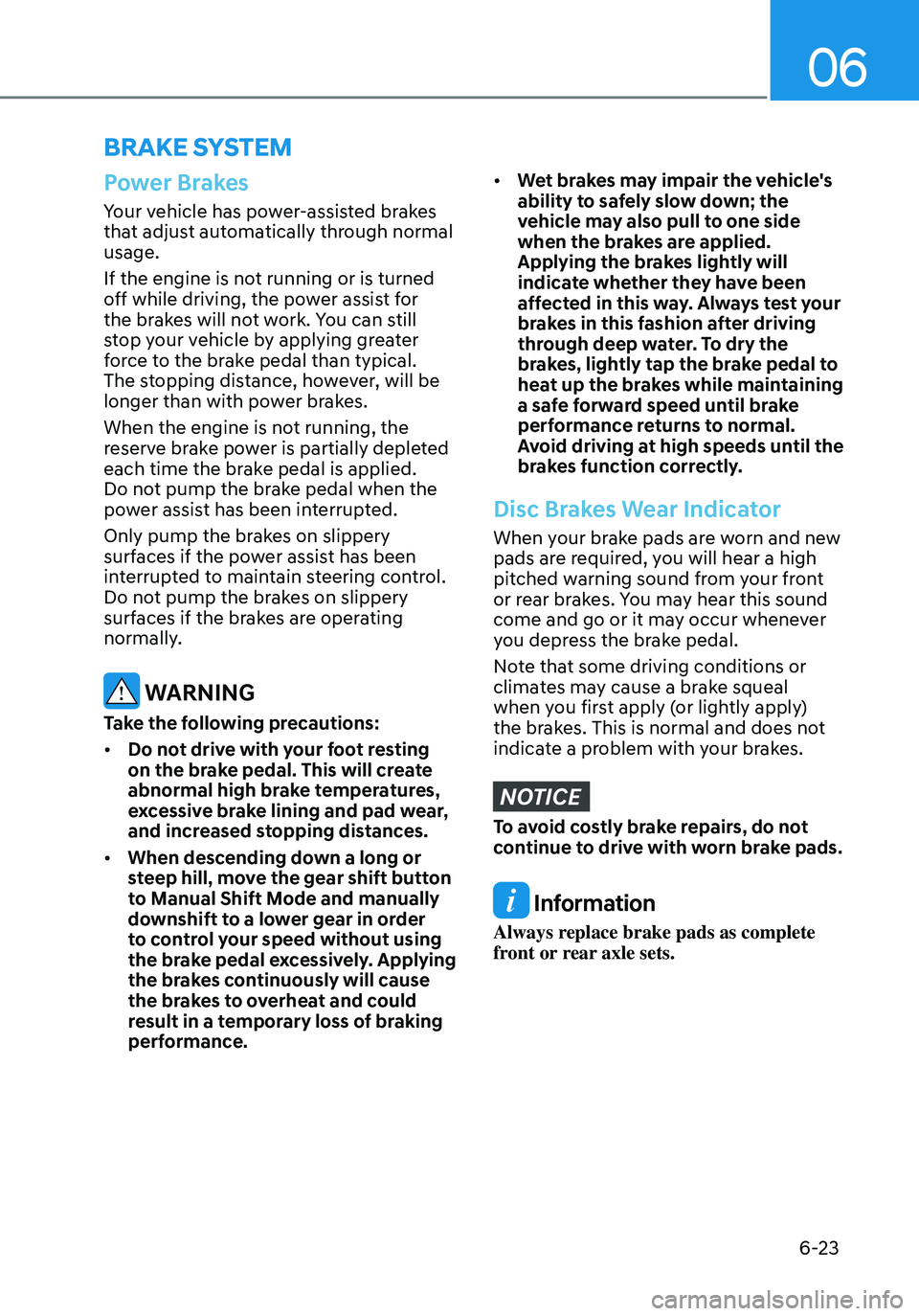
06
6-23
BRAKE SYSTEM
Power Brakes
Your vehicle has power-assisted brakes
that adjust automatically through normal
usage.
If the engine is not running or is turned
off while driving, the power assist for
the brakes will not work. You can still
stop your vehicle by applying greater
force to the brake pedal than typical.
The stopping distance, however, will be
longer than with power brakes.
When the engine is not running, the
reserve brake power is partially depleted
each time the brake pedal is applied.
Do not pump the brake pedal when the
power assist has been interrupted.
Only pump the brakes on slippery
surfaces if the power assist has been
interrupted to maintain steering control.
Do not pump the brakes on slippery
surfaces if the brakes are operating
normally.
WARNING
Take the following precautions:
• Do not drive with your foot resting
on the brake pedal. This will create
abnormal high brake temperatures,
excessive brake lining and pad wear,
and increased stopping distances.
• When descending down a long or
steep hill, move the gear shift button
to Manual Shift Mode and manually
downshift to a lower gear in order
to control your speed without using
the brake pedal excessively. Applying
the brakes continuously will cause
the brakes to overheat and could
result in a temporary loss of braking
performance.
• Wet brakes may impair the vehicle's
ability to safely slow down; the
vehicle may also pull to one side
when the brakes are applied.
Applying the brakes lightly will
indicate whether they have been
affected in this way. Always test your
brakes in this fashion after driving
through deep water. To dry the
brakes, lightly tap the brake pedal to
heat up the brakes while maintaining
a safe forward speed until brake
performance returns to normal.
Avoid driving at high speeds until the
brakes function correctly.
Disc Brakes Wear Indicator
When your brake pads are worn and new
pads are required, you will hear a high
pitched warning sound from your front
or rear brakes. You may hear this sound
come and go or it may occur whenever
you depress the brake pedal.
Note that some driving conditions or
climates may cause a brake squeal
when you first apply (or lightly apply)
the brakes. This is normal and does not
indicate a problem with your brakes.
NOTICE
To avoid costly brake repairs, do not
continue to drive with worn brake pads.
Information
Always replace brake pads as complete
front or rear axle sets.
Page 449 of 555
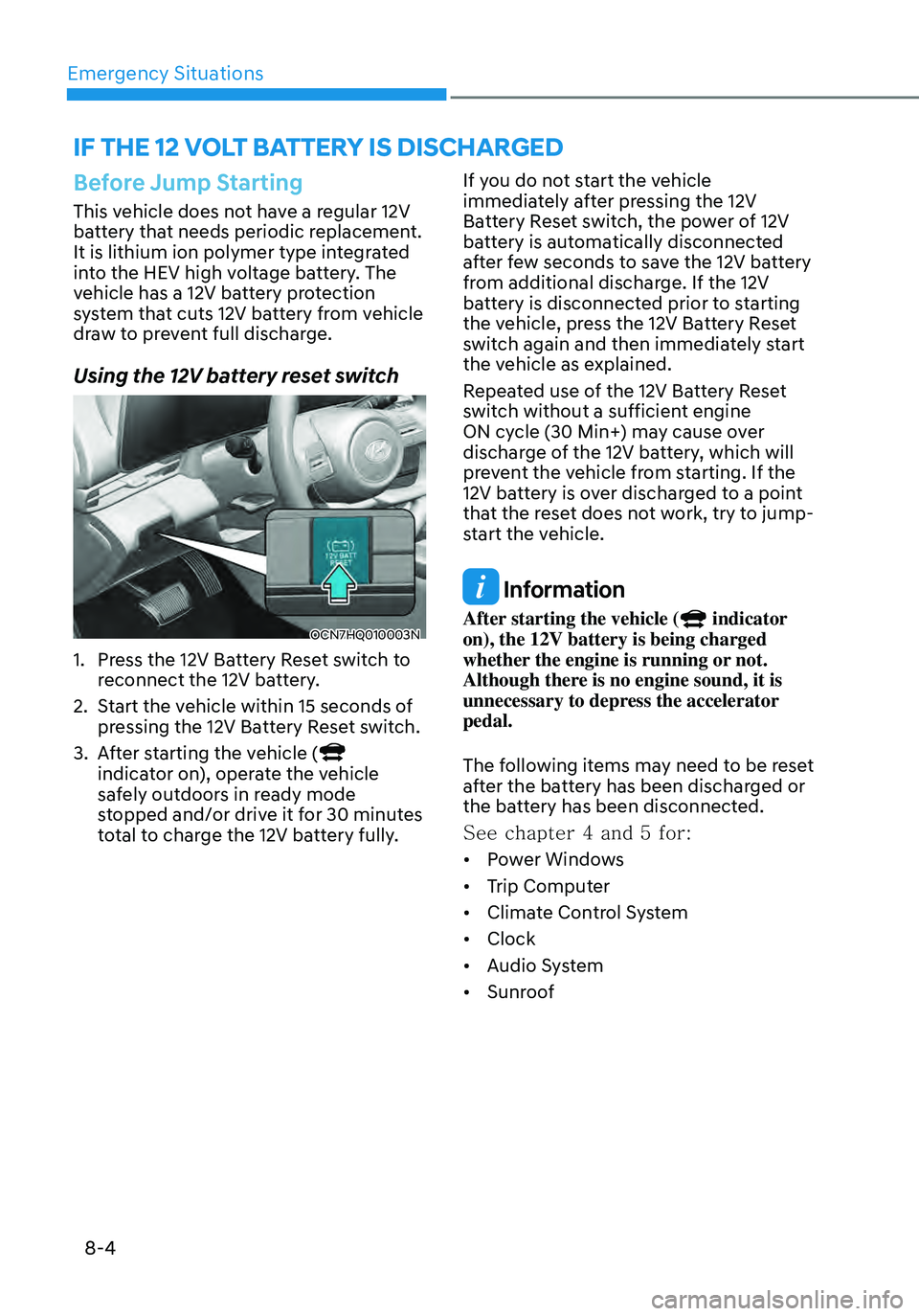
Emergency Situations
8-4
Before Jump Starting
This vehicle does not have a regular 12V
battery that needs periodic replacement.
It is lithium ion polymer type integrated
into the HEV high voltage battery. The
vehicle has a 12V battery protection
system that cuts 12V battery from vehicle
draw to prevent full discharge.
Using the 12V battery reset switch
OCN7HQ010003N
1. Press the 12V Battery Reset switch to
reconnect the 12V battery.
2. Start the vehicle within 15 seconds of
pressing the 12V Battery Reset switch.
3. After starting the vehicle ( indicator on), operate the vehicle
safely outdoors in ready mode
stopped and/or drive it for 30 minutes
total to charge the 12V battery fully.If you do not start the vehicle
immediately after pressing the 12V
Battery Reset switch, the power of 12V
battery is automatically disconnected
after few seconds to save the 12V battery
from additional discharge. If the 12V
battery is disconnected prior to starting
the vehicle, press the 12V Battery Reset
switch again and then immediately start
the vehicle as explained.
Repeated use of the 12V Battery Reset
switch without a sufficient engine
ON cycle (30 Min+) may cause over
discharge of the 12V battery, which will
prevent the vehicle from starting. If the
12V battery is over discharged to a point
that the reset does not work, try to jump-
start the vehicle.
Information
After starting the vehicle ( indicator on), the 12V battery is being charged
whether the engine is running or not.
Although there is no engine sound, it is
unnecessary to depress the accelerator
pedal.
The following items may need to be reset
after the battery has been discharged or
the battery has been disconnected.
See chapter 4 and 5 for:
•
Power Windows
• Trip Computer
• Climate Control System
• Clock
• Audio System
• Sunroof
IF THE 12 VOLT BATTERY IS DISCHARGED
Page 493 of 555
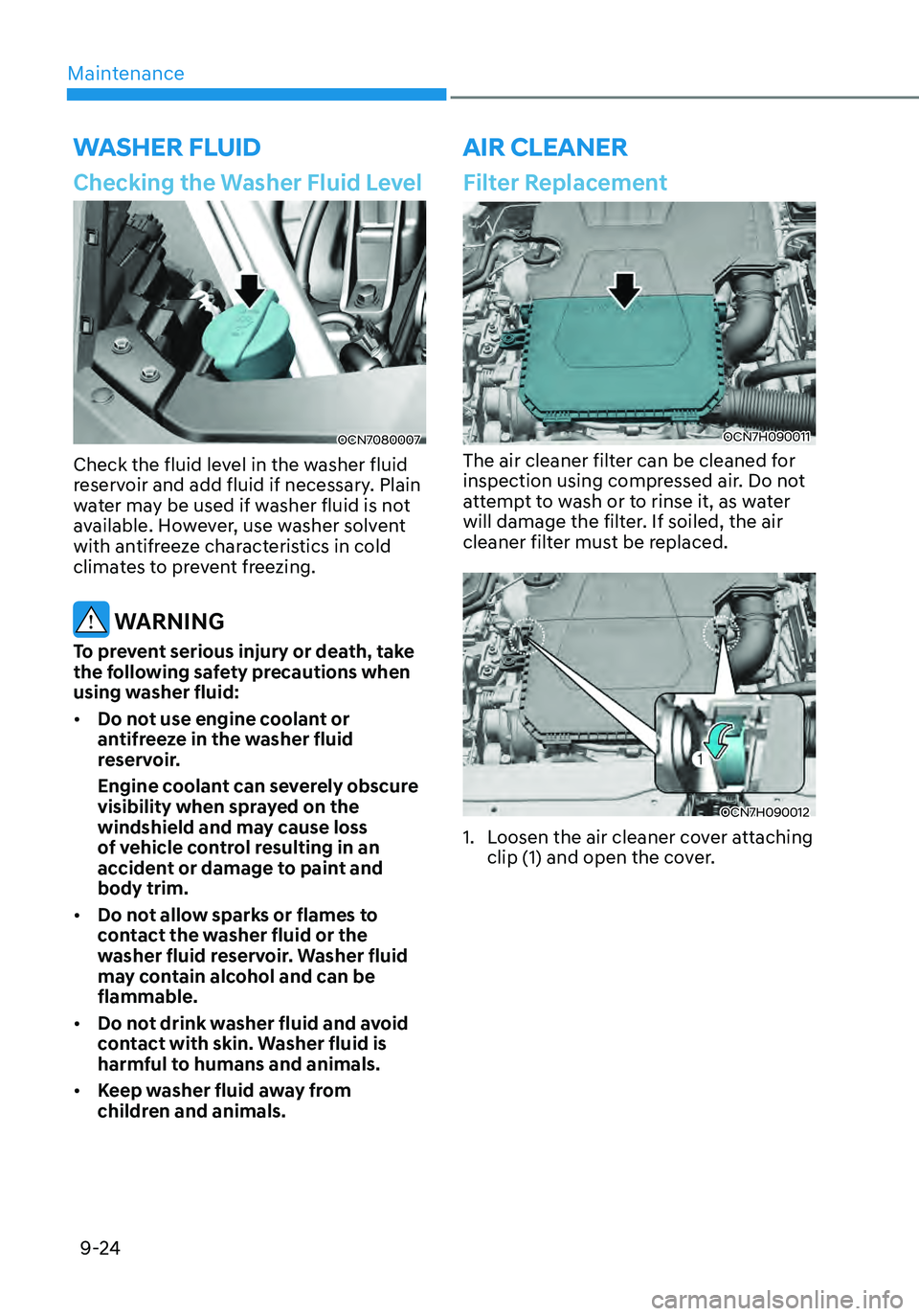
Maintenance
9-24
Checking the Washer Fluid Level
OCN7080007
Check the fluid level in the washer fluid
reservoir and add fluid if necessary. Plain
water may be used if washer fluid is not
available. However, use washer solvent
with antifreeze characteristics in cold
climates to prevent freezing.
WARNING
To prevent serious injury or death, take
the following safety precautions when
using washer fluid:
• Do not use engine coolant or
antifreeze in the washer fluid
reservoir.
Engine coolant can severely obscure
visibility when sprayed on the
windshield and may cause loss
of vehicle control resulting in an
accident or damage to paint and
body trim.
• Do not allow sparks or flames to
contact the washer fluid or the
washer fluid reservoir. Washer fluid
may contain alcohol and can be
flammable.
• Do not drink washer fluid and avoid
contact with skin. Washer fluid is
harmful to humans and animals.
• Keep washer fluid away from
children and animals.
WASHER FLUID
Filter Replacement
OCN7H090011
The air cleaner filter can be cleaned for
inspection using compressed air. Do not
attempt to wash or to rinse it, as water
will damage the filter. If soiled, the air
cleaner filter must be replaced.
OCN7H090012
1. Loosen the air cleaner cover attaching
clip (1) and open the cover.
AIR CLEANER
Page 502 of 555
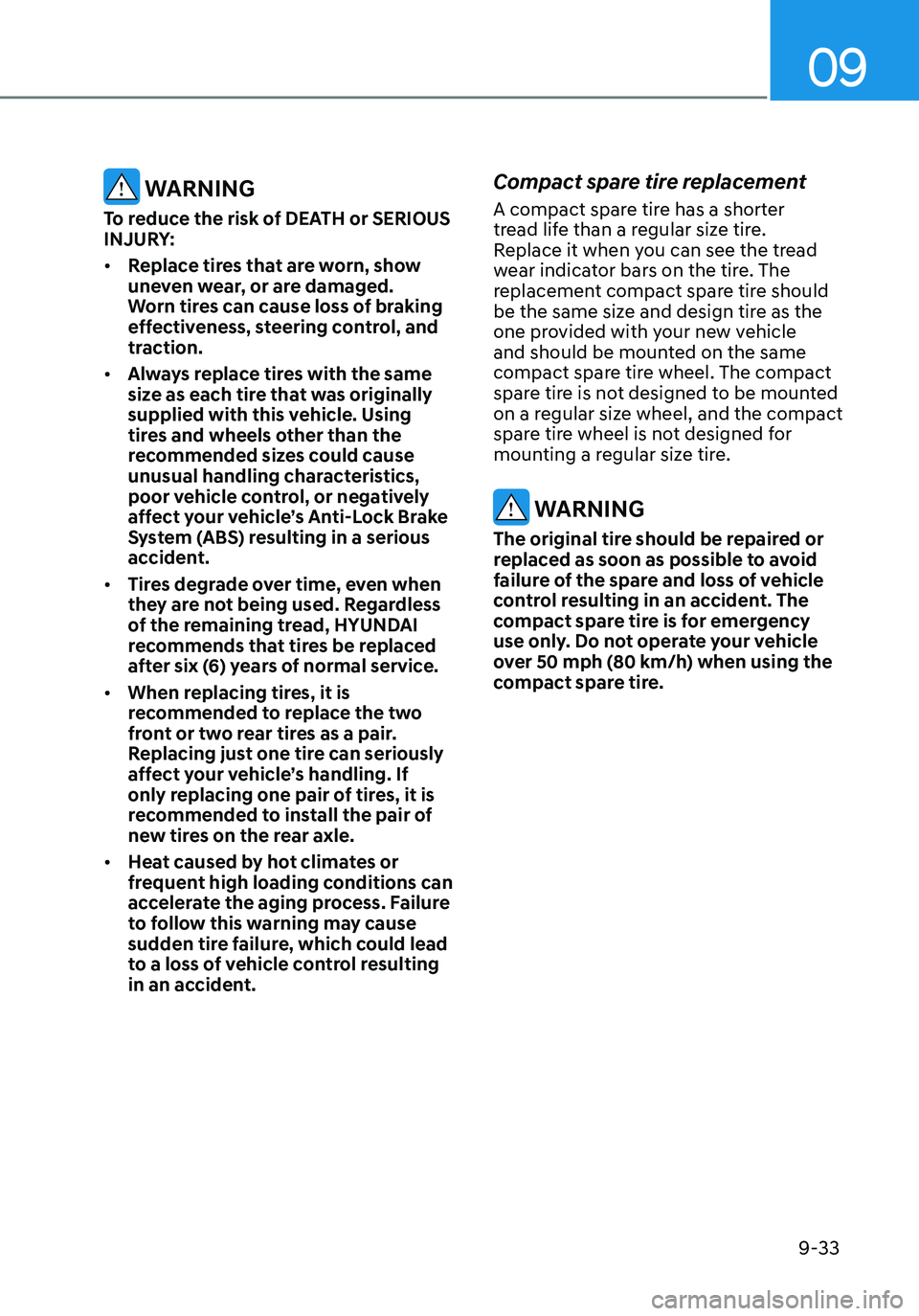
09
9-33
WARNING
To reduce the risk of DEATH or SERIOUS
INJURY:
• Replace tires that are worn, show
uneven wear, or are damaged.
Worn tires can cause loss of braking
effectiveness, steering control, and
traction.
• Always replace tires with the same
size as each tire that was originally
supplied with this vehicle. Using
tires and wheels other than the
recommended sizes could cause
unusual handling characteristics,
poor vehicle control, or negatively
affect your vehicle’s Anti-Lock Brake
System (ABS) resulting in a serious
accident.
• Tires degrade over time, even when
they are not being used. Regardless
of the remaining tread, HYUNDAI
recommends that tires be replaced
after six (6) years of normal service.
• When replacing tires, it is
recommended to replace the two
front or two rear tires as a pair.
Replacing just one tire can seriously
affect your vehicle’s handling. If
only replacing one pair of tires, it is
recommended to install the pair of
new tires on the rear axle.
• Heat caused by hot climates or
frequent high loading conditions can
accelerate the aging process. Failure
to follow this warning may cause
sudden tire failure, which could lead
to a loss of vehicle control resulting
in an accident.
Compact spare tire replacement
A compact spare tire has a shorter
tread life than a regular size tire.
Replace it when you can see the tread
wear indicator bars on the tire. The
replacement compact spare tire should
be the same size and design tire as the
one provided with your new vehicle
and should be mounted on the same
compact spare tire wheel. The compact
spare tire is not designed to be mounted
on a regular size wheel, and the compact
spare tire wheel is not designed for
mounting a regular size tire.
WARNING
The original tire should be repaired or
replaced as soon as possible to avoid
failure of the spare and loss of vehicle
control resulting in an accident. The
compact spare tire is for emergency
use only. Do not operate your vehicle
over 50 mph (80 km/h) when using the
compact spare tire.
Page 505 of 555
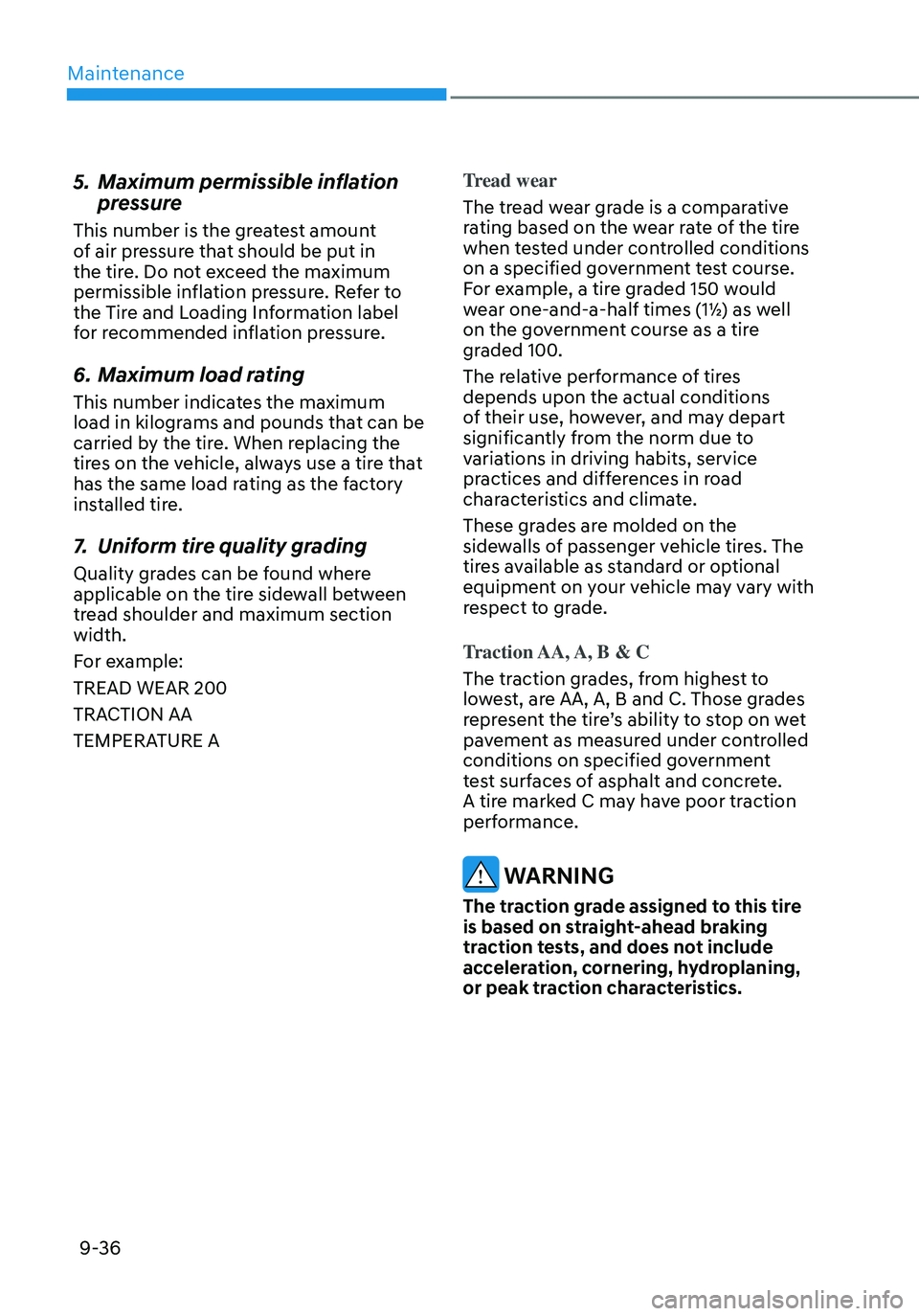
Maintenance
9-36
5. Maximum permissible inflation
pressure
This number is the greatest amount
of air pressure that should be put in
the tire. Do not exceed the maximum
permissible inflation pressure. Refer to
the Tire and Loading Information label
for recommended inflation pressure.
6. Maximum load rating
This number indicates the maximum
load in kilograms and pounds that can be
carried by the tire. When replacing the
tires on the vehicle, always use a tire that
has the same load rating as the factory
installed tire.
7. Uniform tire quality grading
Quality grades can be found where
applicable on the tire sidewall between
tread shoulder and maximum section
width.
For example:
TREAD WEAR 200
TRACTION AA
TEMPERATURE ATread wear
The tread wear grade is a comparative
rating based on the wear rate of the tire
when tested under controlled conditions
on a specified government test course.
For example, a tire graded 150 would
wear one-and-a-half times (1½) as well
on the government course as a tire
graded 100.
The relative performance of tires
depends upon the actual conditions
of their use, however, and may depart
significantly from the norm due to
variations in driving habits, service
practices and differences in road
characteristics and climate.
These grades are molded on the
sidewalls of passenger vehicle tires. The
tires available as standard or optional
equipment on your vehicle may vary with
respect to grade.
Traction AA, A, B & C
The traction grades, from highest to
lowest, are AA, A, B and C. Those grades
represent the tire’s ability to stop on wet
pavement as measured under controlled
conditions on specified government
test surfaces of asphalt and concrete.
A tire marked C may have poor traction
performance.
WARNING
The traction grade assigned to this tire
is based on straight-ahead braking
traction tests, and does not include
acceleration, cornering, hydroplaning,
or peak traction characteristics.
Page 544 of 555
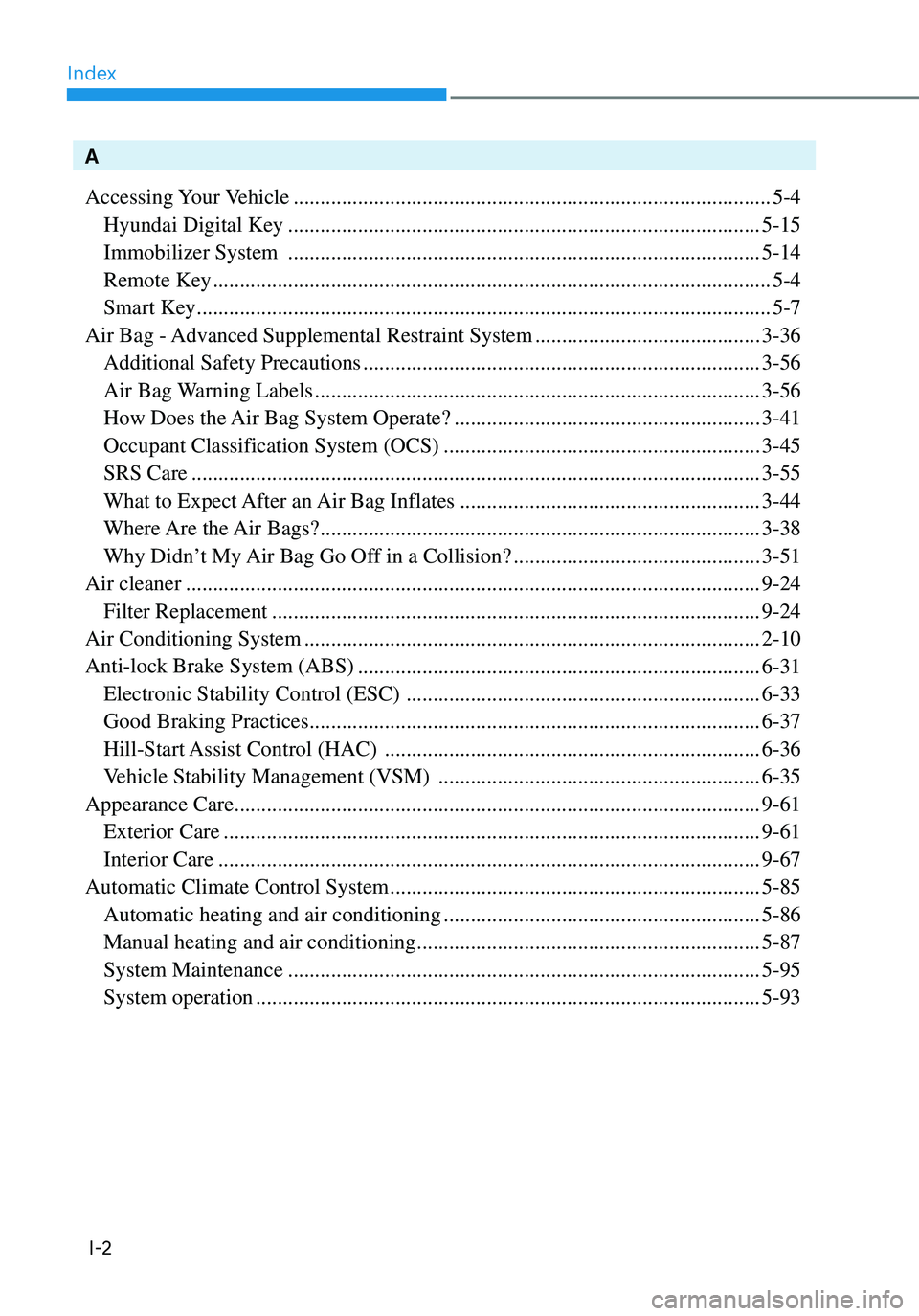
Index
I-2
A
Accessing Your Vehicle
........................................................................\
.................5-4
Hyundai Digital Key ........................................................................\
................5-15
Immobilizer System ........................................................................\
................5-14
Remote Key ........................................................................\
................................5-4
Smart Key ........................................................................\
...................................5-7
Air Bag - Advanced Supplemental Restraint System
..........................................3-36
Additional Safety Precautions ........................................................................\
..3-56
Air Bag Warning Labels ........................................................................\
...........3-56
How Does the Air Bag System Operate? .........................................................3-41
Occupant Classification System (OCS) ...........................................................3-45
SRS Care ........................................................................\
..................................3-55
What to Expect After an Air Bag Inflates ........................................................3-44
Where Are the Air Bags? ........................................................................\
..........3-38
Why Didn’t My Air Bag Go Off in a Collision? ..............................................3-51
Air cleaner
........................................................................\
...................................9-24
Filter Replacement ........................................................................\
...................9-24
Air Conditioning System
........................................................................\
.............2-10
Anti-lock Brake System (ABS)
........................................................................\
...6-31
Electronic Stability Control (ESC) ..................................................................6-33
Good Braking Practices ........................................................................\
............6-37
Hill-Start Assist Control (HAC) ......................................................................6-36
Vehicle Stability Management (VSM) ............................................................6-35
Appearance Care
........................................................................\
..........................9-61
Exterior Care ........................................................................\
............................9-61
Interior Care ........................................................................\
.............................9-67
Automatic Climate Control System
.....................................................................5-85
Automatic heating and air conditioning ...........................................................5-86
Manual heating and air conditioning ................................................................5-87
System Maintenance ........................................................................\
................5-95
System operation ........................................................................\
......................5-93
Page 545 of 555
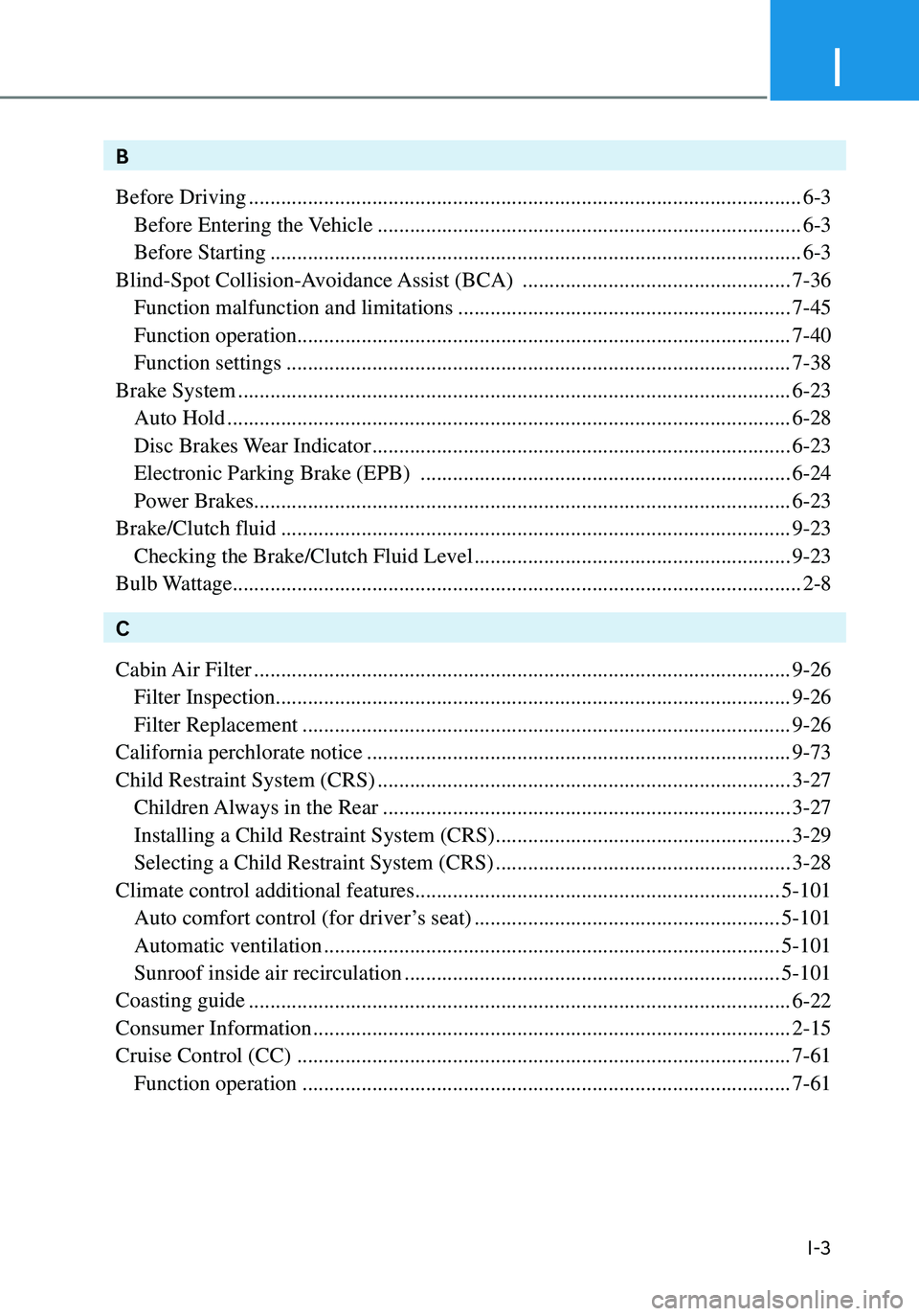
I
I-3
B
Before Driving
........................................................................\
...............................6-3
Before Entering the Vehicle ........................................................................\
.......6-3
Before Starting ........................................................................\
...........................6-3
Blind-Spot Collision-Avoidance Assist (BCA)
..................................................7-36
Function malfunction and limitations ..............................................................7-45
Function operation ........................................................................\
....................7-40
Function settings ........................................................................\
......................7-38
Brake System
........................................................................\
...............................6-23
Auto Hold ........................................................................\
.................................6-28
Disc Brakes W ear Indicator ........................................................................\
......6-23
Electronic Parking Brake (EPB) .....................................................................6-24
Power Brakes ........................................................................\
............................6-23
Brake/Clutch fluid
........................................................................\
.......................9-23
Checking the Brake/Clutch Fluid Level ...........................................................9-23
Bulb Wattage
........................................................................\
..................................2-8
C
Cabin Air Filter
........................................................................\
............................9-26
Filter Inspection ........................................................................\
........................9-26
Filter Replacement ........................................................................\
...................9-26
California perchlorate notice
........................................................................\
.......9-73
Child Restraint System (CRS)
........................................................................\
.....3-27
Children Always in the Rear ........................................................................\
....3-27
Installing a Child Restraint System (CRS) .......................................................3-29
Selecting a Child Restraint System (CRS) .......................................................3-28
Climate control additional features
....................................................................5-101
Auto comfort control (for driver’ s seat) .........................................................5-101
Automatic ventilation ........................................................................\
.............5-101
Sunroof inside air recirculation ......................................................................5-101
Coasting guide
........................................................................\
.............................6-22
Consumer Information
........................................................................\
.................2-15
Cruise Control (CC)
........................................................................\
....................7-61
Function operation ........................................................................\
...................7-61
Page 555 of 555
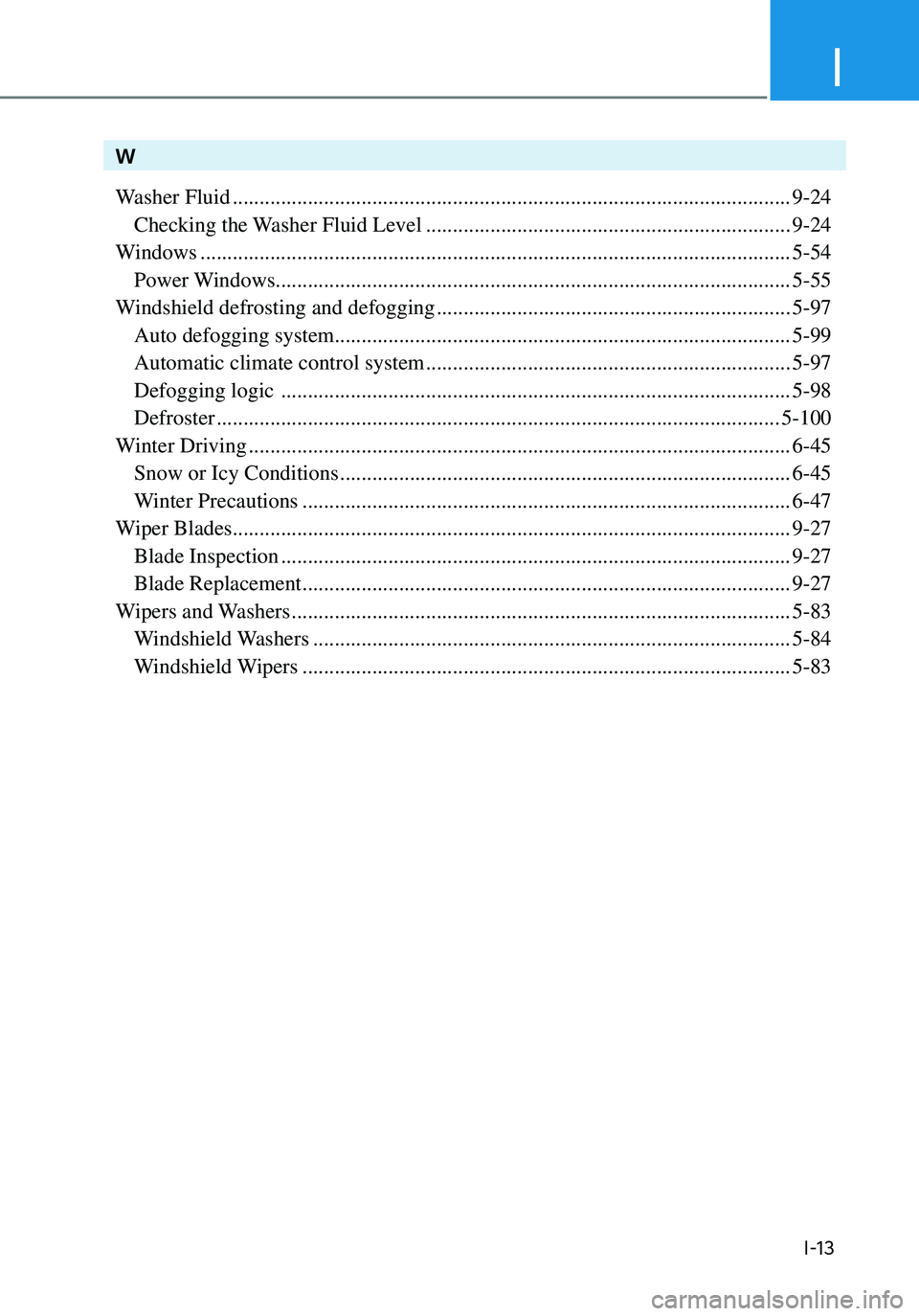
I
I-13
W
Washer Fluid
........................................................................\
................................9-24
Checking the Washer Fluid Level ....................................................................9-24
Windows
........................................................................\
......................................5-54
Power Windows ........................................................................\
........................5-55
Windshield defrosting and defogging
..................................................................5-97
Auto defogging system ........................................................................\
.............5-99
Automatic climate control system ....................................................................5-97
Defogging logic ........................................................................\
.......................5-98
Defroster ........................................................................\
.................................5-100
Winter Driving
........................................................................\
.............................6-45
Snow or Icy Conditions ........................................................................\
............6-45
Winter Precautions ........................................................................\
...................6-47
Wiper Blades
........................................................................\
................................9-27
Blade Inspection ........................................................................\
.......................9-27
Blade Replacement ........................................................................\
...................9-27
Wipers and Washers
........................................................................\
.....................5-83
Windshield Washers ........................................................................\
.................5-84
Windshield Wipers ........................................................................\
...................5-83